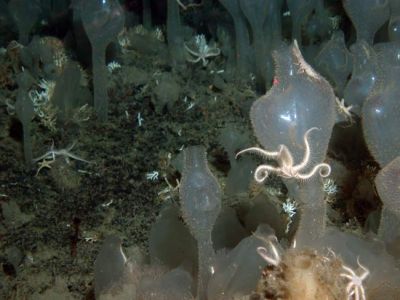It turned out that bones were found in ancient jellyfish, the process of evolution so far covered

Including jellyfish animals drifting in the seaKushida classIs basically known as having no skeleton. However, the fossils of the newly discovered Rhododendron species have a skeleton and it turned out that they once existed as bone-bearing animals. It is a shock to researchers as it fundamentally reverses the beliefs of evolutionary beliefs.
A vanished history of skeletonization in Cambrian comb jellies | Science Advances
http://advances.sciencemag.org/content/1/6/e1500092
Ancient comb jellies had skeletons, but they still lost the arms race | The Verge
http://www.theverge.com/2015/7/10/8929251/comb-jellies-skeletons
Rhododendrons (comb animals) are different from jellyfishes such as so-called mongolia, but they have a soft body, many are colorless and transparent, most of the tissues are made of moisture, similar to jellyfish It is appearance. Hold tentacles and mainly supplement plankton and others.
There are 100-150 kinds of Cranny Clusters classified at present, each of which has a body that is quenched and none have skeleton. However, it was newly discovered that there were hard bones in the ancient quince mushrooms.
The fossils of the Kusakurei fossils discovered this time were Cambrian, had no tentacle, had eight hard plates centered on sensory devices at the apex of the body. Some seeds have solid bones like "backbone" that can keep the skeleton even if the joints are separated. The researchers said the eight plates had eight hard plates inside the body, centered on sensory devices at the apex of the body. It is considered to be "to protect yourself from predators" or "to protect you from environmental changes".

There are no skeletons like those found in the fossils discovered this time in the current Cranny Clams. As a result, the species of living things has increased explosivelyCambrian explosionAlthough there is a view that it is a type of organism born in, it is still the opposite result to the previous DNA analysis showing that "Ancestor of Kushigurage had a tentacle". In addition, when a skeleton which had no skeleton originally developed skeleton,Evolutionary arms raceIt could also be a hint that there was a big environmental change in the ancient Cambrian.

Although it became a discovery that goes against the research so far, there are species that have not been discovered in jellyfishes on the other hand, and new species have been reported in Australia last year. The strange thing about a new kind of jellyfish named "Keesingia gigas" is that you do not have a tentacle that jellyfish would normally have. However, despite this, scientists who were studying Keesingia gigas are pricked by this jellyfish and host pain, nausea, vomiting, etc.Ilukangji syndromeIt was the point that it had developed.
New jellyfish discovered: giant venomous species found off Australia | World news | The Guardian
http://www.theguardian.com/world/2014/aug/08/new-jellyfish-discovered-giant-venomous-species-found-off-australia

In addition, beautiful images of jellyfish that seems to be cool just by watching can be enjoyed from the following movies.
Endless Gravity // 14-BIT RAW on Vimeo
Related Posts:







